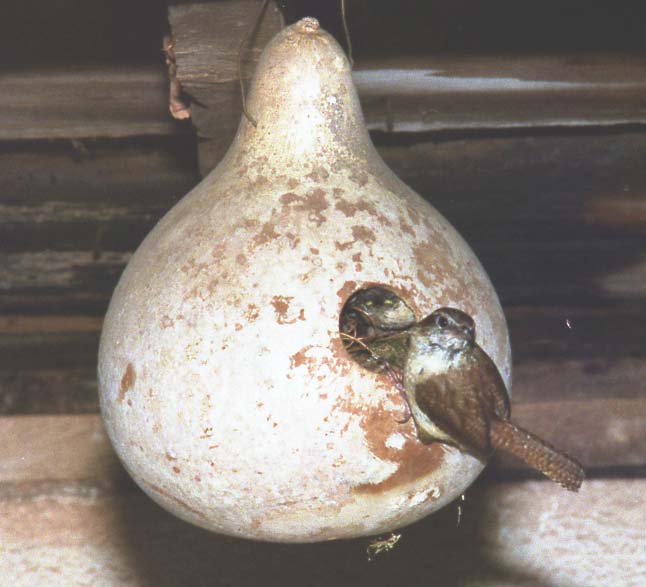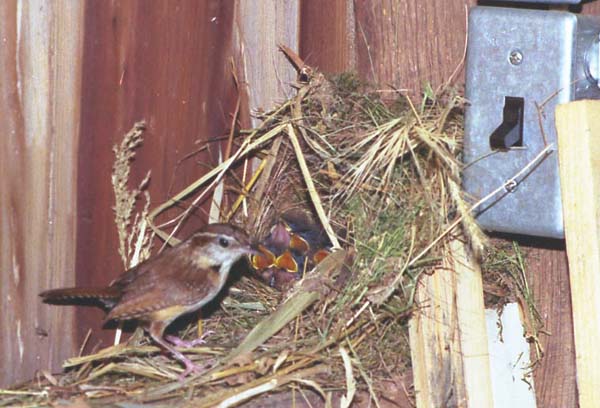


Our Carolina wrens have been having two broods each year since 2004, and usually in surprising places. This year the first nesting was in an old gourd hanging in the entrance way to the lower workshop. This gourd is provided for house wrens, to keep them away from the nest boxes. House wrens had used it every year lately, so I didn't realize that it was being used by Carolina wrens until the young were almost ready to fledge. When they did fledge, several ended up in the workshop, scurreying around under the machines and benches. Both adult and juvenile Carolina wrens usually take evasive action by keeping low and hiding under things, rather than the usual avian response of flying up up and away. After trying to coax the fledglings out of the shop for several minutes, it became apparent that even finding all of them under the various machines was an impossible task. But, a large door at the opposite end of the shop allowed the adults to find and feed the young. Several hours later, four nestlings were observed on vines along the barn wall.
The wrens moved to the second floor shop for their second nesting. As usual, their nest site selection was unfortunate (for me), but it worked out well for them. They built on a batten adjacent to a light switch that I must use when entering the second floor at night. This meant that I had to leave the second floor before dark, since reaching for the light switch would scare the female off the nest and she wouldn't be able to return to the nest in the dark. She didn't mind my approaching within 4 or 5 feet of the nest, so we coexisted nicely during the day. Or, more likely, she endured my close approach because she didn't want to give away the location of the nest by flying off. I placed a video camera several inches from the nest and recorded video on several days. The photos were taken remotely while watching live video. Each night all windows and the large rolling doors of the second floor are closed to keep out the big brown bats, but the wrens were using an opening unknown to me to enter without needing to wait for me to open the doors. There was a small knot hole close to their nest and narrow openings around the big doors,
but I never noticed which the wrens might be using.
 While the female was incubating or brooding, the male would often perch just inside the big door and break out in song. This was often the familiar "tea kettle - tea kettle - tea kettle" call, but he had several other variations. His singing was loud and seemed amplified in the cavernous barn. I was always pleasantly startled when the silence would be suddenly broken by such loud song.
While the female was incubating or brooding, the male would often perch just inside the big door and break out in song. This was often the familiar "tea kettle - tea kettle - tea kettle" call, but he had several other variations. His singing was loud and seemed amplified in the cavernous barn. I was always pleasantly startled when the silence would be suddenly broken by such loud song.
As always, the five young left this nest before they could fly and were fed on the floor the first day. By the second day, they were flying and out of the barn. In previous years, the newly fledged wrens would often hop around for 3 days before taking to the air.
The nest location with eggs. Note the light switch.
older nestlings venturing out of the nest.
Out of the nest and on to the floor.
Feeding 3 other nestlings on the floor
.
| barn owl | American kestrel | purple martin | barn swallow | Eastern bluebird |
| tufted titmouse | Eastern phoebe | yellow shafted flicker | tree swallow | chimney swift |
| house wren | big brown bat | Carolina wren | brown thrasher | catbird |
| cedar waxwing | Northern mockingbird | |||
| Yellow warbler | Acadian flycatcher | |||
email richard@americanartifacts.com
© 2011, American Artifacts and Richard Van Vleck, Taneytown, Maryland.